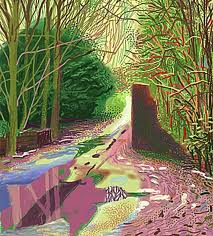David Hockney interview by Andrew Marr
David Hockney is an influential living painter who has lived in California for many years, but started to paint his home landscape in Bridlington, East Yorkshire while on a regular Christmas visit to his mothers,' and stayed for six years. His father had been a conscientious objector and his mother a Methodist.
His paintings are filled with vivid and vibrant colours, painted on several canvases that have been put together like a jigsaw. He said that these landscapes had to be large and majestic. He has also filmed the landscape during the four seasons, using eight cameras, placed in the same locations throughout the seasons. These films move in a timeless sequence so that what you are given is a feast of colour and the seasonal changes as they naturally occur. I felt drawn into the film sequences and could have watched them for ages.
David Hockney has "come home." He is now in the latter part of his life, and as happens when you mature and grow older, the landscape of your youth returns to your hear and mind as somewhere that pulls you back to rediscover it. At least this is the way I see it. Now that I am getting older, I too look at the landscape of my upbringing as somewhere that I need to document at some stage in the future. There is nothing like it. Memories of the landscape of youth are powerful emotions and with age comes a recognition of its beauty and impact on your life.
As David Hockney spoke about his work, he said that scale is an important factor in seeing the Bigger Picture, as a way to view the landscape because it is itself sometimes imposing and sometimes all encompassing. He said that the Chinese see the landscape as something you walk through, the Europeans see it as if looking through a window at a fixed point. A Chinese saying he recalled was "Painting is an old man's art" and he spoke of there being an urgency in making the art and that they gold a lifetime of experience.
Hockney has been greatly influenced by Pablo Picasso's Still Life's. Duchamp's Woman Walking Down Stairs, Cubism's art of depicting space,the dramatic sense of space and the Cubist experience of space "Where I end, you being." He said of the Grand Canyon that is is a "Big Spacial Thrill." Hockney admitted that he is "Affected by Space, it thrills me" this can be seen in mot of his work, as in the Swimming Pools of his Californian paintings.
He has used the IPad to sketch and paint examples of work starting work on his canvases. The colours are wonderfully expressive and capture the mood of his pallet. There are so many different hues of colour and he said that you have to really look at what's around you to realise that its not just green, or just red, there are so many variations of colour when you stop to look long enough. He has captured this in his paintings which really are magnificent works of art. I am only sorry that I will not have the opportunity to view them. The exhibition in London is already fully booked and it does not run for long enough, in my mind.
All the canvases are being hung in their seasonal order. Picasso said "give me a museum and I will fill it" David Hockney has the same sentiment. he has been given the whole of the Gallery Space to show his work and you can walk through it from one season to the next. wonderful.
A few quotes for the programme ....
"You can teach the craft but its the poetry you cant teach" David Hockney
"It's what the artist does, not what he says" Henry Matisse
"There's never bad weather in Britain" John Ruskin
"An Artist can support hedonism, but he cant be a hedonist because he has to work to hard" David Hockney.
I thoroughly enjoyed viewing this programme, and it is so relevant to my work as a photographic artist. Seeing the light is the ultimate beginning and end to the way I photograph, and the way I see the world around me and the work I try to produce.






+Albumen+print+purchased+by+Queen+Victoria,+Royal+Collection+%C2%A9+2011+HM+Queen+Elizabeth+II.jpg)









